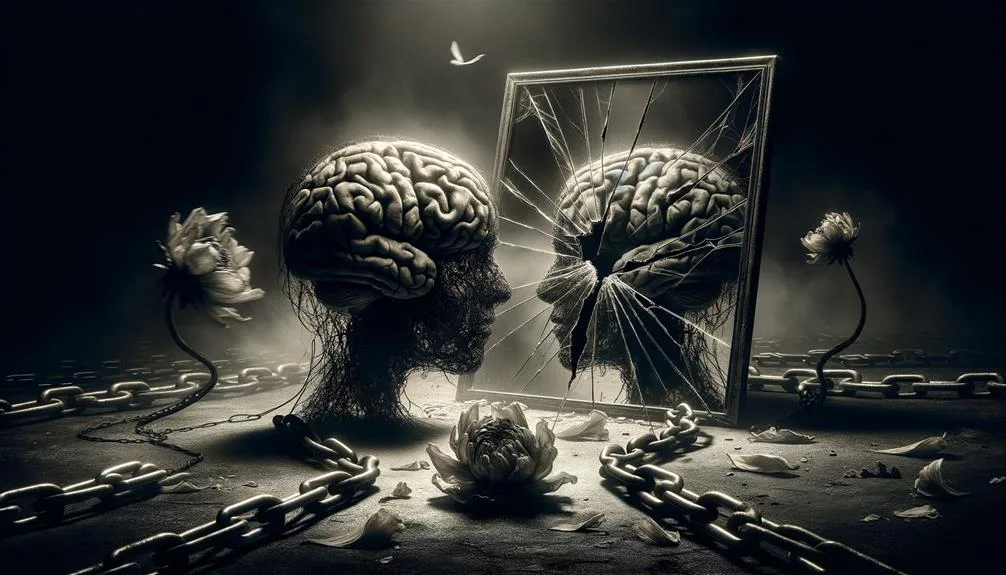You're familiar with the story of John—a high-flying executive whose penchant for working 80-hour weeks seemed like dedication but was, in fact, a ticking time bomb of self-destruction. It's a common scenario: the harder you push, the closer you edge towards a breakdown.
Your friends express concern, but you shrug it off, convinced that you're just driven, not on the verge of collapse. Yet, beneath this veneer of commitment lies an array of complex psychological triggers. Unbeknownst to you, these triggers are silently orchestrating a symphony of chaos within your life.
As you stand in the eye of the storm, you're left wondering what could possibly be at the root of these seemingly impenetrable patterns. If you're ready to uncover these hidden forces and take control of your future, it's time to embark on an exploration into the intricate landscape of the human psyche, where answers await those brave enough to seek them.
Key Takeaways
- Self-destructive behavior is a manifestation of various underlying issues such as low self-worth, lack of self-esteem, and coping mechanisms for stress and pressure.
- Self-destructive behavior can take many forms, including physical self-harm, self-pity, drug and alcohol abuse, social self-alienation, and hiding from emotions.
- Engaging in self-destructive behavior hinders personal growth, fulfillment, and overall well-being, leading to long-term suffering and negative consequences.
- Overcoming self-destructive behavior requires seeking professional help, developing healthy coping mechanisms, cultivating self-love and self-acceptance, and building a strong support system.
Roots of Self-Sabotage
Understanding the roots of self-sabotage is crucial, as it's often a subconscious process where you undermine your own goals and well-being. This behavior stems from a complex interplay of psychological factors, including a lack of understanding self-worth. Self-sabotage isn't just a random pattern; it's a sign that you're struggling to believe in your intrinsic value. By recognizing this, you're already on the path to breaking the cycle of self-sabotage.
An analytical look reveals that self-sabotage often functions as a misguided self-protection mechanism. It may shield you from the fear of failure or the anxiety of stepping outside your comfort zone. However, empathetically acknowledging your worth and working scientifically on your self-esteem can gradually dismantle these harmful patterns, paving the way to a more self-compassionate and fulfilling life.
Recognizing Harmful Patterns

Recognizing harmful patterns in your behavior is the first step towards dismantling the subconscious strategies that undermine your well-being. It's about identifying the recurring actions that lead you into a spiral of negativity and distress. Breaking the cycle requires an analytical eye, examining the chain of events and emotions that precede your self-destructive choices.
With empathy, acknowledge the struggle within you – the battle between the desire for growth and the comfort of familiarity. The scientific approach lies in observing your behavior as data points, noticing trends without judgment. Finding inner strength isn't just a feeling; it's a scientifically-backed process of reprogramming your neural pathways through consistent, positive habits.
Understanding these patterns is a crucial part of the journey towards a healthier, more fulfilling life.
Overcoming Emotional Avoidance

As we acknowledge the harmful patterns that negate our well-being, it's equally crucial to confront the emotional avoidance that often fuels these behaviors. Emotional avoidance is a defense mechanism where you dodge processing emotions, thereby missing the opportunity for personal growth. Embracing vulnerability is not just cathartic; it is scientifically proven to enhance emotional resilience.
The table below outlines steps to overcome emotional avoidance:
| Strategy | Benefit |
|---|---|
| Acknowledge & Label Emotions | Facilitates processing and understanding |
| Practice Mindfulness | Builds presence and awareness |
| Seek Support | Provides validation and perspective |
Healing From Substance Misuse

Embarking on the journey to heal from substance misuse requires a multifaceted approach that addresses both the physical dependencies and the emotional wounds driving the behavior. Overcoming addiction isn't just about stopping the use of substances; it's about understanding the underlying reasons for your actions and finding support systems to aid in your recovery.
Consider these steps:
- Engage in therapy to explore the root causes of your addiction.
- Develop coping strategies for dealing with cravings and emotional distress.
- Build a network of support, including friends, family, and support groups.
- Commit to a healthy lifestyle, incorporating nutrition, exercise, and mindfulness practices.
This analytical and empathetic approach will help you navigate the complexities of healing from substance misuse.
Nurturing Positive Connections

While addressing the root causes of addiction is crucial, it's equally important to nurture positive connections that can provide emotional sustenance and reinforce your recovery journey. Building healthy relationships is a foundation for breaking isolation, which often exacerbates destructive behavior.
It's through these relationships that you receive support, constructive feedback, and a sense of belonging. Scientific studies underscore the significance of social support in enhancing mental health and resilience. By engaging with others who understand and encourage your growth, you're fostering an environment conducive to healing.
Surround yourself with individuals who uplift you, rather than those who pull you back into negative patterns. Remember, the quality of your connections matters more than the quantity. Seek depth and sincerity in your relationships to ensure a robust network that bolsters your wellbeing.
Frequently Asked Questions
How Does Societal and Cultural Conditioning Contribute to the Development of Self-Destructive Behaviors?
Societal expectations and cultural norms can push you toward self-destructive behaviors. You're often influenced by peer pressure, leading to harmful habits that align with perceived social acceptance rather than personal well-being.
Can Self-Destructive Behavior Be a Genetic Predisposition, and What Role Does Family History Play in This?
You may have genetic markers that predispose you to self-destructive behavior, while epigenetic influences from your family's history can also play a role in shaping these tendencies. It's complex but important to understand.
How Do Self-Destructive Behaviors Differ Among Various Age Groups, Such as Adolescents Compared to Adults?
Adolescents often act on impulse, like a spark igniting quickly, while adults might use self-destructive behaviors as a coping mechanism, akin to a slow burn harming them over time. Both need understanding and support.
What Is the Impact of Technology and Social Media on Self-Destructive Behavior in the Modern Age?
You're facing increased self-destructive behavior with technology's rise. Online anonymity fuels cyberbullying, prompting digital detoxification needs. It's crucial to manage your social media influence for mental well-being.
How Does One Differentiate Between Self-Destructive Behavior and Seeking Extreme Experiences for Personal Growth or Thrill?
You're treading a fine line; self-destructive behavior lacks risk assessment, while seeking thrills involves thrill differentiation, often with a safety net. Analyze your motives and consequences to distinguish between the two.
Conclusion
You've embarked on a crucial journey, unmasking the specters that haunt your choices. It's not just about breaking chains; it's a rebirth. By understanding the roots, you're nurturing resilience.
Embrace this metamorphosis, for every step towards healing is a leap towards the light. Remember, the strongest steel is forged in the fiercest fire.
Now, you're not just surviving; you're thriving, sculpting a future where self-love and positive connections illuminate your once shadowed path.

